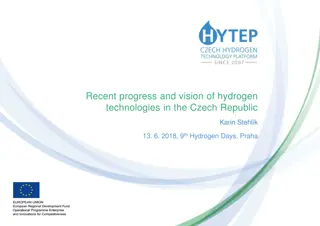Unraveling the Origin of Earth and Moon through Hydrogen Isotopes in Small Lunar Samples
Exploring the D/H ratios in small lunar samples, researchers suggest a distinctive region in the lunar mantle might hold material from planetary bodies, impacting the Moon's hydrogen component. The Desch-Robinson model combines geochemical data and planet formation models to propose how the Moon formed, including the delivery of an unusual hydrogen component by a collision with the proto-Earth. The model's four-stage overview illustrates the occurrence of ultra-low D/H water pockets inside the Moon.
Download Presentation

Please find below an Image/Link to download the presentation.
The content on the website is provided AS IS for your information and personal use only. It may not be sold, licensed, or shared on other websites without obtaining consent from the author.If you encounter any issues during the download, it is possible that the publisher has removed the file from their server.
You are allowed to download the files provided on this website for personal or commercial use, subject to the condition that they are used lawfully. All files are the property of their respective owners.
The content on the website is provided AS IS for your information and personal use only. It may not be sold, licensed, or shared on other websites without obtaining consent from the author.
E N D
Presentation Transcript
Hydrogen Isotopes in Small Lunar Samples Provide Clues to the Origin of the Earth and Moon Apollo 15 QMD samples have exceptionally low D/H ratios (see blue-shaded area in the plot), distinctly lower than other types of lunar rocks (red-shaded area). The QMD values are almost as low as the D value of the solar nebula (shown by yellow-shaded band). Low D/H ratios of QMDs indicate that a distinctive region of the lunar mantle might contain materials from planetary bodies large enough to trap gas from the solar nebula. How was this unusual hydrogen component added to the Moon? Researchers Desch and Robinson suggest that it was delivered by the collision between the proto-Earth and the Moon- forming impactor, often called Theia. Apollo 15 samples that cooled slowly and crystallized in magma chambers below the lunar surface are called "quartz monzodiorites , nicknamed QMDs. http://www.psrd.hawaii.edu/Mar20/moon-formation-hydrogen.html
Hydrogen Isotopes in Small Lunar Samples Provide Clues to the Origin of the Earth and Moon The Desch-Robinson model is an excellent illustration of how measured geochemical data can be combined with models of planet formation and the chemistry inferred for the solar nebula to test ideas for how the Moon formed. Four-stage overview of the model of how water with ultra-low D/H occurs in pockets inside the Moon. Stage 1 Initial Conditions http://www.psrd.hawaii.edu/Mar20/moon-formation-hydrogen.html
Hydrogen Isotopes in Small Lunar Samples Provide Clues to the Origin of the Earth and Moon The Desch-Robinson model is an excellent illustration of how measured geochemical data can be combined with models of planet formation and the chemistry inferred for the solar nebula to test ideas for how the Moon formed. nebula to test ideas for how the Moon formed. The Desch-Robinson model is an excellent illustration of how measured geochemical data can be combined with models of planet formation and the chemistry inferred for the solar Four-stage overview of the model of how water with ultra-low D/H occurs in pockets inside the Moon. Four-stage overview of the model of how water with ultra-low D/H occurs in pockets inside the Moon. Stage 2 Planet Evolution http://www.psrd.hawaii.edu/Mar20/moon-formation-hydrogen.html
Hydrogen Isotopes in Small Lunar Samples Provide Clues to the Origin of the Earth and Moon The Desch-Robinson model is an excellent illustration of how measured geochemical data can be combined with models of planet formation and the chemistry inferred for the solar nebula to test ideas for how the Moon formed. nebula to test ideas for how the Moon formed. The Desch-Robinson model is an excellent illustration of how measured geochemical data can be combined with models of planet formation and the chemistry inferred for the solar Four-stage overview of the model of how water with ultra-low D/H occurs in pockets inside the Moon. Four-stage overview of the model of how water with ultra-low D/H occurs in pockets inside the Moon. Stage 3 Giant Impact http://www.psrd.hawaii.edu/Mar20/moon-formation-hydrogen.html
Hydrogen Isotopes in Small Lunar Samples Provide Clues to the Origin of the Earth and Moon The Desch-Robinson model is an excellent illustration of how measured geochemical data can be combined with models of planet formation and the chemistry inferred for the solar nebula to test ideas for how the Moon formed. nebula to test ideas for how the Moon formed. The Desch-Robinson model is an excellent illustration of how measured geochemical data can be combined with models of planet formation and the chemistry inferred for the solar Four-stage overview of the model of how water with ultra-low D/H occurs in pockets inside the Moon. Four-stage overview of the model of how water with ultra-low D/H occurs in pockets inside the Moon. Stage 4 Final Products http://www.psrd.hawaii.edu/Mar20/moon-formation-hydrogen.html























